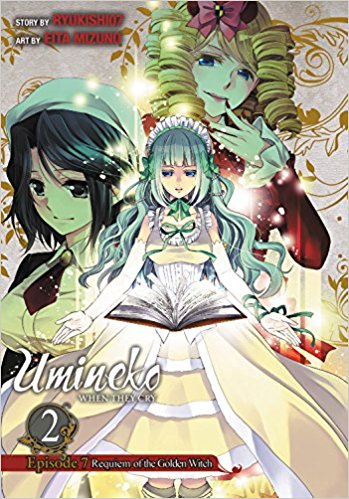Story by Ryukishi07; Art by Eita Mizuno. Released in Japan in three separate volumes as “Umineko no Naku Koro ni: Requiem of the Golden Witch” by Square Enix, serialized in the magazine Shonen Gangan. Released in North America by Yen Press. Translated by Stephen Paul.
Last time we finally got the answer to the riddle of the Epitaph, as well as the revelation of who Beatrice is, though that answer required jumping through a few hoops to avoid showing us a face. For the conclusion of this penultimate arc, however, the answers come fast and furious. In fact, one complaint of the audience that had read the original visual novels is that they’re a bit too much like looking at the answer sheet. When Clair and Will face off, we get her declarations, and we see his sword bluntly cutting them off. But the floating words literally stating what happened in the first four arcs was added to the manga especially. Apparently fans had started to get a bit over the top about how there was no real answer to the arcs, and this was Ryukishi07’s response (he worked closely with the mangaka for the last two arcs especially). And here we also find out the truth of what REALLY happened in 1986. Though, like Ange, I don’t think you’re going to like it.
One of the things that was made very clear was that Kinzo’s magic was money. Money is what has the power to make miracles. And so the solution to what really happens, once you realize that the parents actually put their heads together and all solved the epitaph together, is depressingly obvious. What’s more, it mirrors some of the battles in the prior arcs. Jessica’s fistfights against Kyrie and Ronove contrast with her pathetic demise here, having her face literally being beaten to a pulp. (There’s always a gore warning for Umineko, by the way, but this volume is particularly bad.) Natsuhi also doesn’t get a chance to fight back, and her death starts the chain of everyone else’s. As for the identity of the culprit, I’ll avoid mentioning it here, but I will say that we discover, as the reader was well aware, that Bernkastel’s goal is to see everyone suffer for her own entertainment, and given who she’s been “helping” for so long, you can probably hazard a guess. That said, I’m not sure EVERYTHING we see is exactly what happened. There’s a conversation between two characters about Ange that seems a bit too on the nose to not be “dialogue provided by Bernkastel”, to be honest.
Even Lion doesn’t manage to escape Bern’s mass slaughter, as Bern reveals that even in the ONE universe where Lion exists, their fate is also preordained. That said, three cheers for Will, who says what we all want to hear: mysteries that just end unhappily for everyone are not fun to read. Will is there to bring the reader hope, even if it means losing an arm and fighting along with Lion against Bern and her nightmarish army of cats. (Lambdadelta is there too, but honestly she’s more a passive audience member than anything else. She enjoys it, but it’s all Bernkastel’s show.) But still… we’ve got one big arc to go. We know what really happened in 1986. Is there any way to give Ange a happy ending in 1998? Bern says no, and she says it in red, so it’s going to be tough. (I recommend the digital version for that page, by the way, as the color red is actually used for the statement, and it gives it a lot of impact.)
Clearly the answer, however, is not to take the opposite tack either. We should not see an arc that shows us how everything was all happiness, sunshine and rainbows in 1986, not after everything we’ve seen involving the Ushiromiya family. But there’s no way anyone’s motivations would be that misguided. Right? Tune in next time for Twilight of the Golden Witch, aka “don’t mention this arc in the presence of an Umineko fan”. Same time, same publisher!





